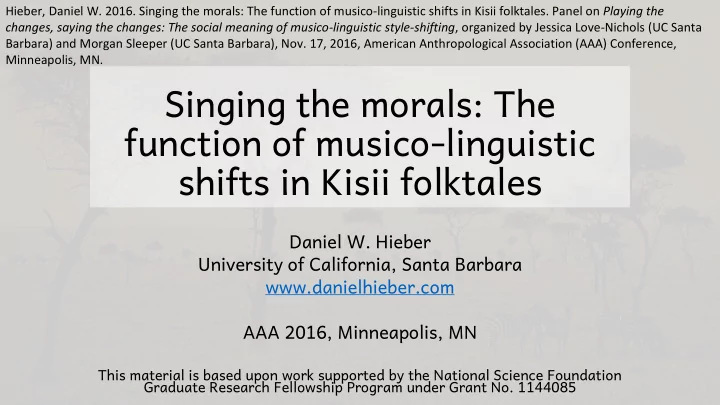

Hieber, Daniel W. 2016. Singing the morals: The function of musico-linguistic shifts in Kisii folktales. Panel on Playing the changes, saying the changes: The social meaning of musico-linguistic style-shifting , organized by Jessica Love-Nichols (UC Santa Barbara) and Morgan Sleeper (UC Santa Barbara), Nov. 17, 2016, American Anthropological Association (AAA) Conference, Minneapolis, MN. Singing the morals: The function of musico-linguistic shifts in Kisii folktales Daniel W. Hieber University of California, Santa Barbara www.danielhieber.com AAA 2016, Minneapolis, MN This material is based upon work supported by the National Science Foundation Graduate Research Fellowship Program under Grant No. 1144085
Kisii (Êkegusiî; Bantu, Niger-Congo) Endangered – few speakers under 30 • 2.2 million ethnic Gusii people, ~600,000 speakers • Ê kegusiî Encyclopedia Project (EEP) • 2 mo. fjeld trip in Summer 2014: 24 folktales; lexical • database with audio (14,000 words)
Generic features of Kisii folktales Self -erasure of the narrator • Personifjcation of the story • Mogano ngôôchá înde? ‘May I, Story, come?’ • Mogano închûó. ‘Story, come.’ • Avoidance of metacommentary and self -correction • No third -party descriptions of mental states •
Generic features of Kisii folktales Characterological types – anthropomorphized animals • Girafge, Lion, Hyena, Hare, etc. • Provides the listener with the proper moralizing stance • Songs • Usually a single stanza, ~ 5 lines in length • Voiced by characters in the story (rather than the narrator) • Integral to the plot • Varied in style – from extremely melodic to very chant-like •
Why song? In the absence of metacommentary, songs are a useful • mechanism by which characters express their attitudes towards events in the narrative. This in turn tells the listener what kind of stance they are • expected to take, on the basis of their prior knowledge of characterological types.
Who sings? 25 stories total • 12 have human main characters • These same 12 stories – and only these stories – have songs • Only humans sing (unless animals are aided by supernatural • means)
Ômwâná ômomurá n ’ êkerandi A boy, a girl, and a gourd Mother wants son to get a • wife Son brings home gourd • Gourd has woman living • inside it Woman does house chores • Mother discovers woman • Mother makes son marry • woman
Ômwâná ômomurá n ’ êkerandi A boy, a girl, and a gourd The song is how we know the attitude of the mother • Refmects common social expectations in Kisii society thatː • a) men fjnd wives to marry b) wives help the women of the husband ’s family with chores The song does the moralizing work of establishing the stance that the • listener is expected to have towards the son’s negligence The ironic fact that the ideal wife is living in the much -criticized gourd • further highlights this contrast more starkly
Âbââná bâtâno bânyɔ́ɔ́rêté chînkɛnɛnɛ Five girls pick some mulberries Five girls go picking mulberries Târí înché nârîêté • êkemânkûrûma. One girl eats all the mulberries • ‘It’s not me who ate them, la di The girls each sing an oath • da.’ promising bad luck if they ate the mulberries Ômotwé êpoopó êkemânkûrûma. When the culprit attempts to ‘Your head bangs, la di da.’ • sing, she cannot Âmagoró êsêngʼîsêngʼí She falls into the river and êkemânkûrûma. • drowns ‘Your legs make noise like crushed glass, la di da.’
Âbââná bâtâno bânyɔ́ɔ́rêté chînkɛnɛnɛ Five girls pick some mulberries Song is the key element telling the audience which moral • stance to take We as listeners are not meant to feel sorry for the girl, but • rather to view her ill fate as punishment for her lie
Ômoîsêké ômonyakîêni A beautiful girl A girl refuses to marry any Girl is given to the river • • suitors beast. The disgruntled boys Suitors take girl away and • • pretend to be river beasts, one marries her and turn the river to blood Father is none the wiser • Father of the girl sings to • the river beast, ofgering various gifts The river beast (i.e. the • suitors) accepts the girl as a gift
Ômoîsêké ômonyakîêni A beautiful girl King Lear -style narrative • World is in chaos until the proper social order is restored (i.e. the • girl is properly married) Father never knows why the river beast wanted the girl • Song informs the audience of what the suitors want, and the • source of wrongness in the world
Conclusion Songs may seem like nothing more than aesthetic ditties • But then why use song at all? • Why at these particular points in the narrative? • Why by these particular characters? •
Conclusion Each of stories show moralizing functions for their songs • Songs provide insights into the attitudes of the characters • Neatly sidesteps the need for third -party metacommentary • Help establish the moral stance that the audience is • expected to take
Recommend
More recommend